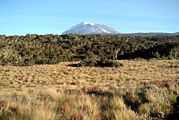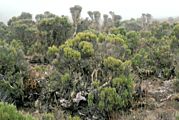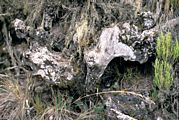Climatic change on Kilimanjaro
In certain areas, indirect effects of climate warming may be more important than direct effects. Front page newspaper reports on the disappearing ice cape of Kilimanjaro, the highest mountain of Africa, do not focus on the actual problem.
Recent studies have clearly documented enhanced fire frequency in the upper montane forest belt of Kilimanjaro. Fire has induced a 300 m downward shift of the Ericaceae treeline. This has far more dramatic consequences for downslope life and hydrology than the loss of the glacier: More than 90 % of the hydrological consequences (water yield) is due to climate-induced loss of cloud forest and not due to the loss of the ice cap.
As in most tropical mountains, precipitation peaks on Kilimanjaro between 2300 and 2800 m elevation. Above this belt, precipitation declines and gives way to a semiarid climate near treeline where fire risk may change rapidly with only small changes of precipitation.



